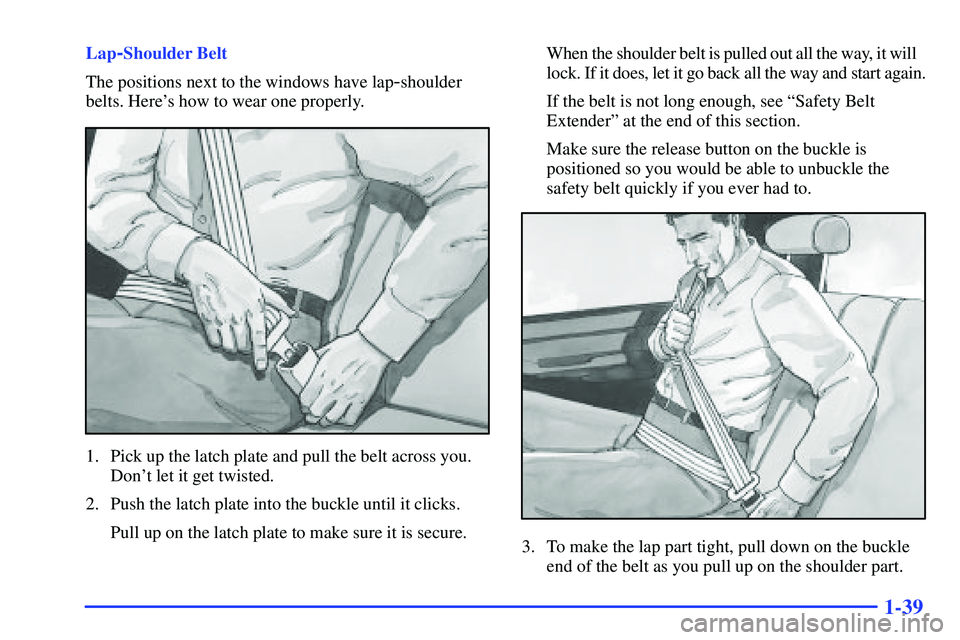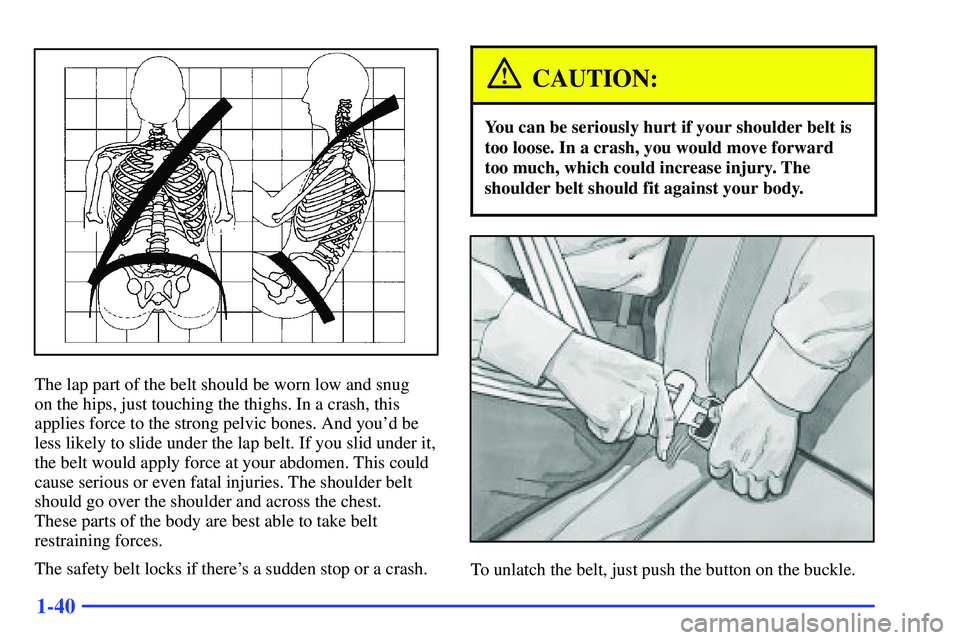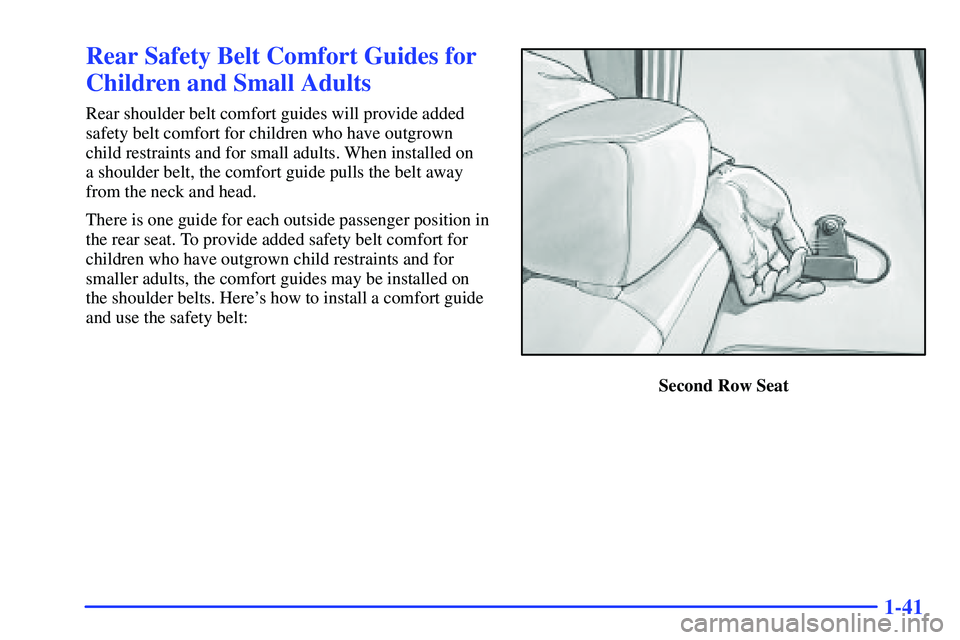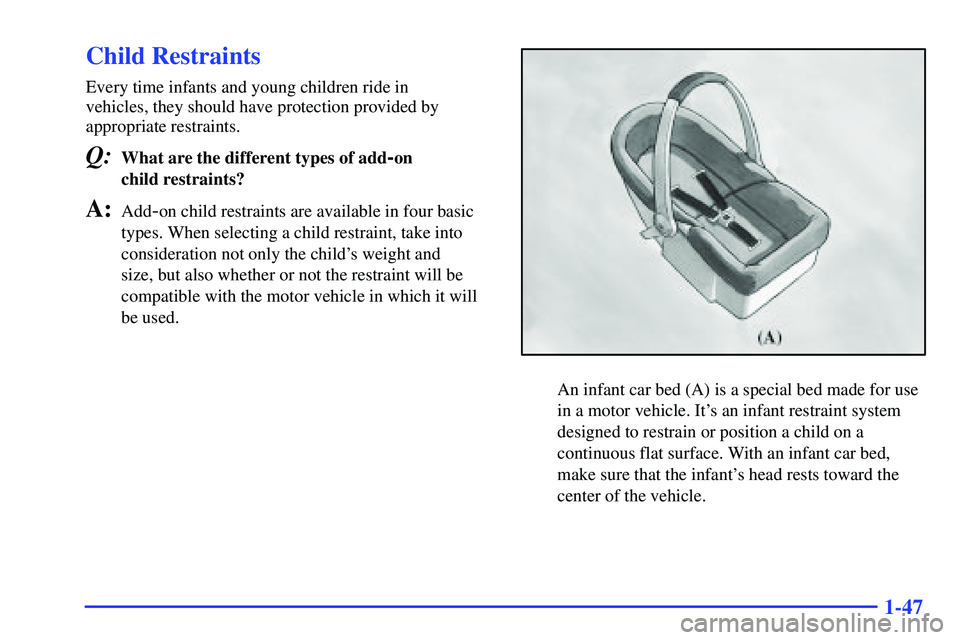GMC YUKON 2000 Workshop Manual
Manufacturer: GMC, Model Year: 2000,
Model line: YUKON,
Model: GMC YUKON 2000
Pages: 413, PDF Size: 3.03 MB
GMC YUKON 2000 Workshop Manual
YUKON 2000
GMC
GMC
https://www.carmanualsonline.info/img/44/35603/w960_35603-0.png
GMC YUKON 2000 Workshop Manual
Trending: Oil pan, fuses, Roof console, towing, spark plugs replace, mirror, oil capacities
Page 51 of 413
1-38
To make the belt shorter, pull its free end as shown until
the belt is snug.
Buckle, position and release it the same way as the lap
part of a lap
-shoulder belt. If the belt isn't long enough,
see ªSafety Belt Extenderº at the end of this section.
Make sure the release button on the buckle is positioned
so you would be able to unbuckle the safety belt quickly
if you ever had to.
Rear Seat Passengers
It's very important for rear seat passengers to buckle up!
Accident statistics show that unbelted people in the rear
seat are hurt more often in crashes than those who are
wearing safety belts.
Rear passengers who aren't safety belted can be thrown
out of the vehicle in a crash. And they can strike others
in the vehicle who are wearing safety belts.
Rear Seat Outside Passenger Positions
Page 52 of 413
1-39
Lap-Shoulder Belt
The positions next to the windows have lap
-shoulder
belts. Here's how to wear one properly.
1. Pick up the latch plate and pull the belt across you.
Don't let it get twisted.
2. Push the latch plate into the buckle until it clicks.
Pull up on the latch plate to make sure it is secure.When the shoulder belt is pulled out all the way, it will
lock. If it does, let it go back all the way and start again.
If the belt is not long enough, see ªSafety Belt
Extenderº at the end of this section.
Make sure the release button on the buckle is
positioned so you would be able to unbuckle the
safety belt quickly if you ever had to.
3. To make the lap part tight, pull down on the buckle
end of the belt as you pull up on the shoulder part.
Page 53 of 413
1-40
The lap part of the belt should be worn low and snug
on the hips, just touching the thighs. In a crash, this
applies force to the strong pelvic bones. And you'd be
less likely to slide under the lap belt. If you slid under it,
the belt would apply force at your abdomen. This could
cause serious or even fatal injuries. The shoulder belt
should go over the shoulder and across the chest.
These parts of the body are best able to take belt
restraining forces.
The safety belt locks if there's a sudden stop or a crash.
CAUTION:
You can be seriously hurt if your shoulder belt is
too loose. In a crash, you would move forward
too much, which could increase injury. The
shoulder belt should fit against your body.
To unlatch the belt, just push the button on the buckle.
Page 54 of 413
1-41
Rear Safety Belt Comfort Guides for
Children and Small Adults
Rear shoulder belt comfort guides will provide added
safety belt comfort for children who have outgrown
child restraints and for small adults. When installed on
a shoulder belt, the comfort guide pulls the belt away
from the neck and head.
There is one guide for each outside passenger position in
the rear seat. To provide added safety belt comfort for
children who have outgrown child restraints and for
smaller adults, the comfort guides may be installed on
the shoulder belts. Here's how to install a comfort guide
and use the safety belt:
Second Row Seat
Page 55 of 413
1-42
Third Row Seat
1. For the second row, remove the guide from its
storage clip on the trim panel near the side of the
seatback. For the third row, remove the guide from
its storage clip on the side of the seatback.2. Place the guide over the belt and insert the two edges
of the belt into the slots of the guide.
Page 56 of 413
1-43
3. Be sure that the belt is not twisted and it lies flat.
The guide must be on top of the belt.Second Row Seat
Page 57 of 413
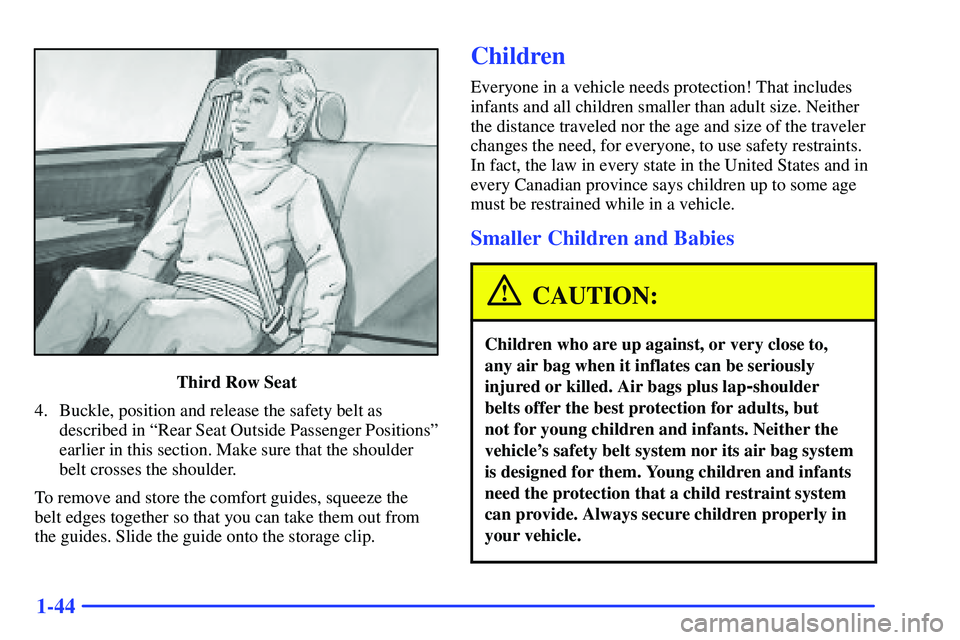
1-44
Third Row Seat
4. Buckle, position and release the safety belt as
described in ªRear Seat Outside Passenger Positionsº
earlier in this section. Make sure that the shoulder
belt crosses the shoulder.
To remove and store the comfort guides, squeeze the
belt edges together so that you can take them out from
the guides. Slide the guide onto the storage clip.
Children
Everyone in a vehicle needs protection! That includes
infants and all children smaller than adult size. Neither
the distance traveled nor the age and size of the traveler
changes the need, for everyone, to use safety restraints.
In fact, the law in every state in the United States and in
every Canadian province says children up to some age
must be restrained while in a vehicle.
Smaller Children and Babies
CAUTION:
Children who are up against, or very close to,
any air bag when it inflates can be seriously
injured or killed. Air bags plus lap
-shoulder
belts offer the best protection for adults, but
not for young children and infants. Neither the
vehicle's safety belt system nor its air bag system
is designed for them. Young children and infants
need the protection that a child restraint system
can provide. Always secure children properly in
your vehicle.
Page 58 of 413
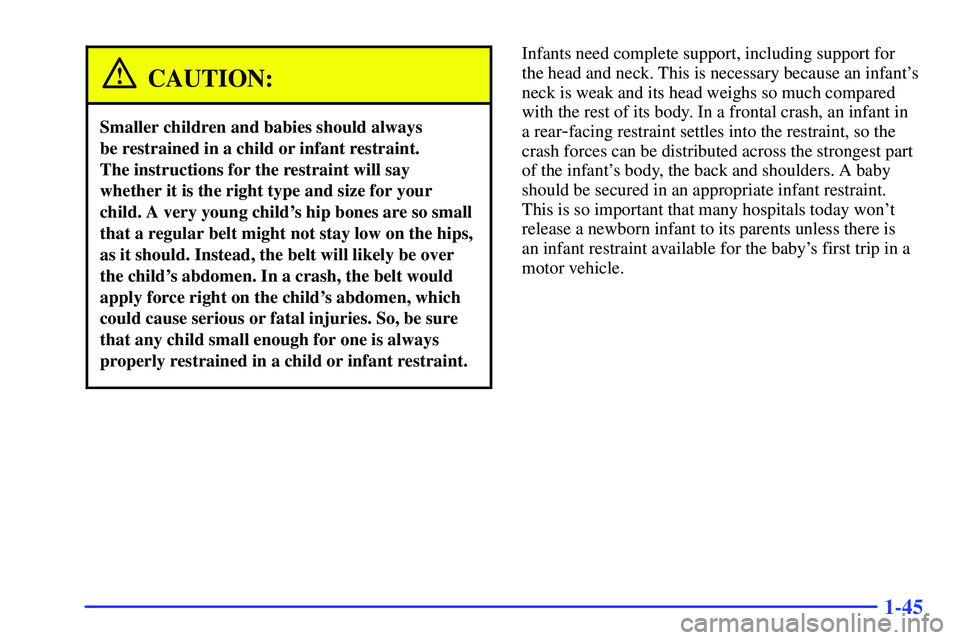
1-45
CAUTION:
Smaller children and babies should always
be restrained in a child or infant restraint.
The instructions for the restraint will say
whether it is the right type and size for your
child. A very young child's hip bones are so small
that a regular belt might not stay low on the hips,
as it should. Instead, the belt will likely be over
the child's abdomen. In a crash, the belt would
apply force right on the child's abdomen, which
could cause serious or fatal injuries. So, be sure
that any child small enough for one is always
properly restrained in a child or infant restraint.
Infants need complete support, including support for
the head and neck. This is necessary because an infant's
neck is weak and its head weighs so much compared
with the rest of its body. In a frontal crash, an infant in
a rear
-facing restraint settles into the restraint, so the
crash forces can be distributed across the strongest part
of the infant's body, the back and shoulders. A baby
should be secured in an appropriate infant restraint.
This is so important that many hospitals today won't
release a newborn infant to its parents unless there is
an infant restraint available for the baby's first trip in a
motor vehicle.
Page 59 of 413
1-46
CAUTION:
Never hold a baby in your arms while riding in
a vehicle. A baby doesn't weigh much
-- until a
crash. During a crash a baby will become so
heavy you can't hold it. For example, in a crash
CAUTION: (Continued)
CAUTION: (Continued)
at only 25 mph (40 km/h), a 12-lb. (5.5 kg) baby
will suddenly become a 240
-lb. (110 kg) force on
your arms. The baby would be almost impossible
to hold.
Secure the baby in an infant restraint.
Page 60 of 413
1-47
Child Restraints
Every time infants and young children ride in
vehicles, they should have protection provided by
appropriate restraints.
Q:What are the different types of add-on
child restraints?
A:Add-on child restraints are available in four basic
types. When selecting a child restraint, take into
consideration not only the child's weight and
size, but also whether or not the restraint will be
compatible with the motor vehicle in which it will
be used.
An infant car bed (A) is a special bed made for use
in a motor vehicle. It's an infant restraint system
designed to restrain or position a child on a
continuous flat surface. With an infant car bed,
make sure that the infant's head rests toward the
center of the vehicle.
Trending: wiring, lock, radio, wheel, jump start terminals, remote start, jump cable

